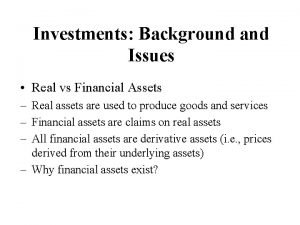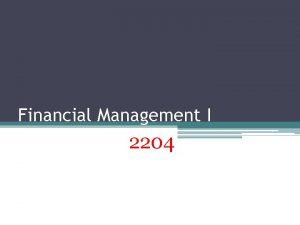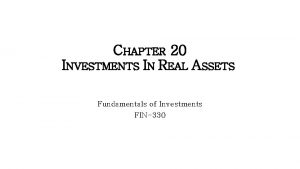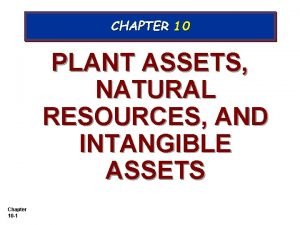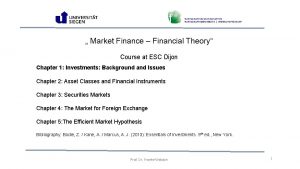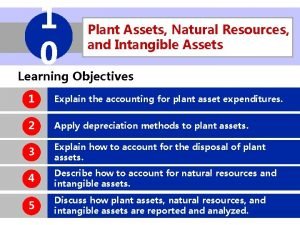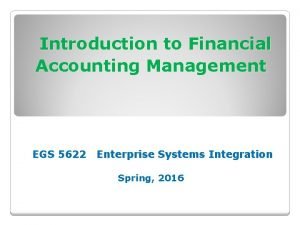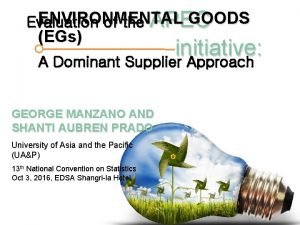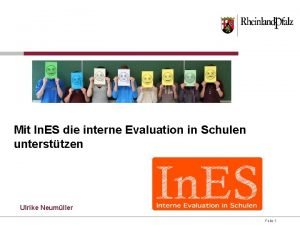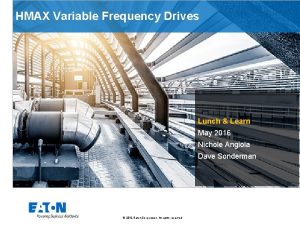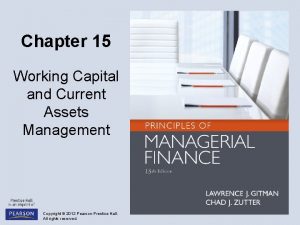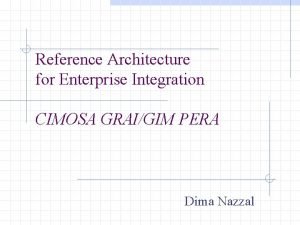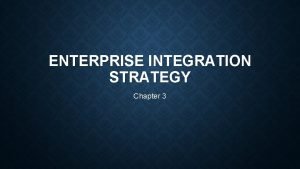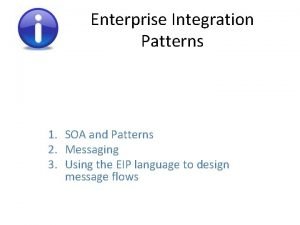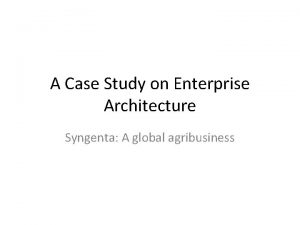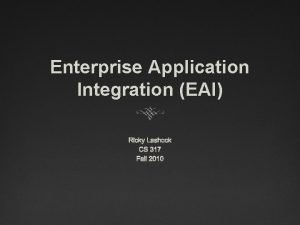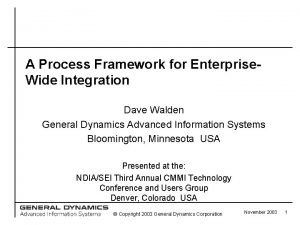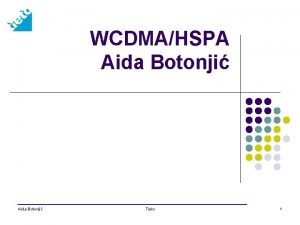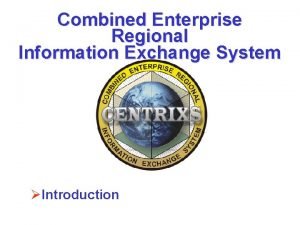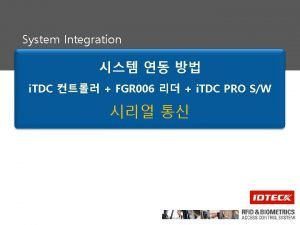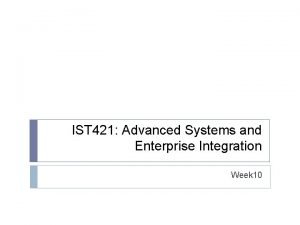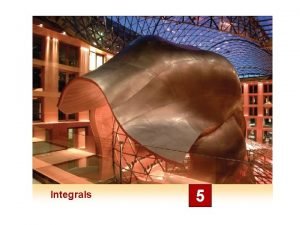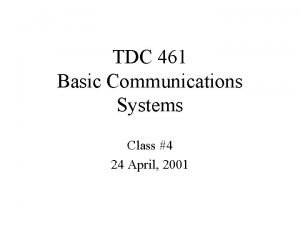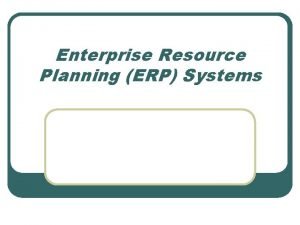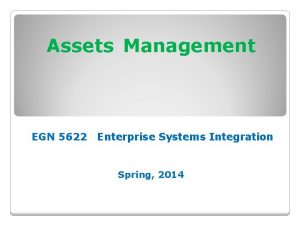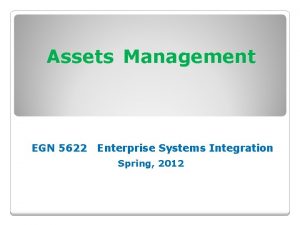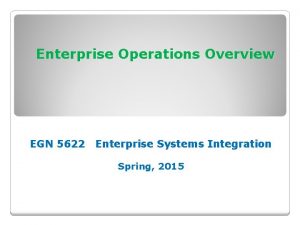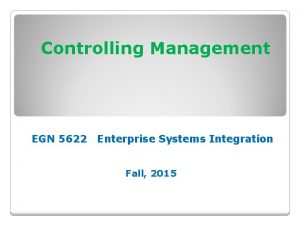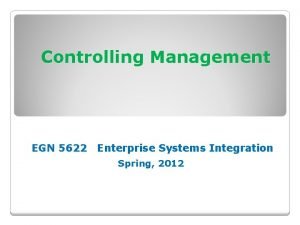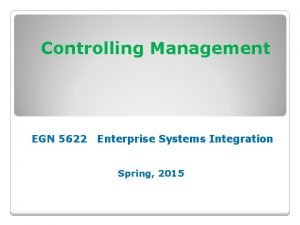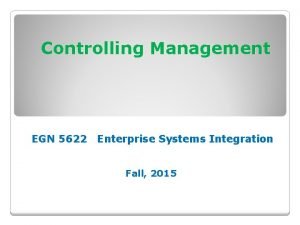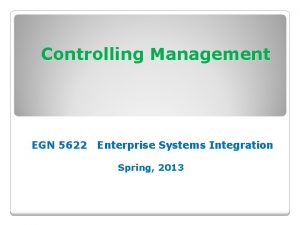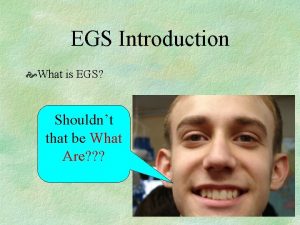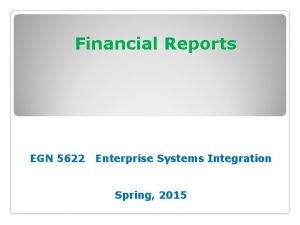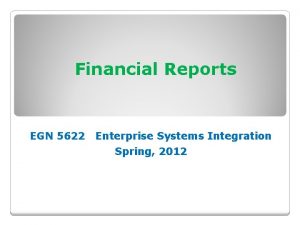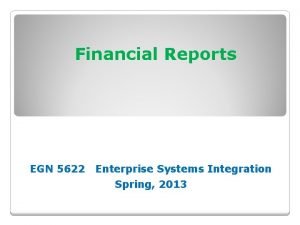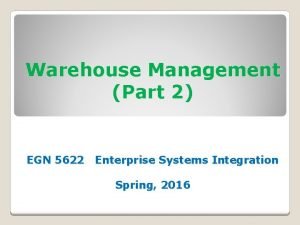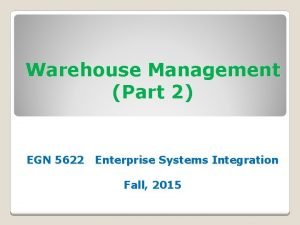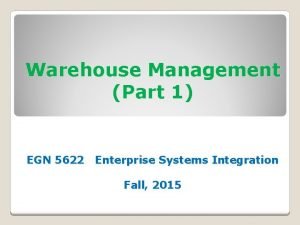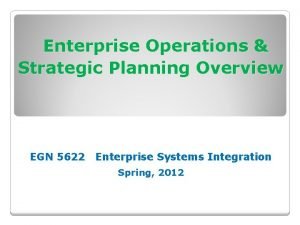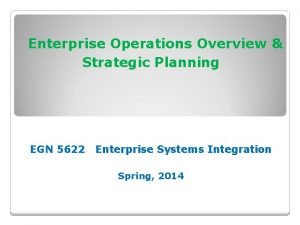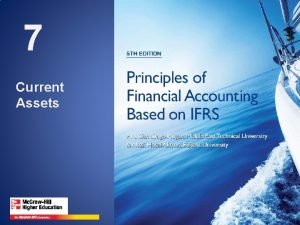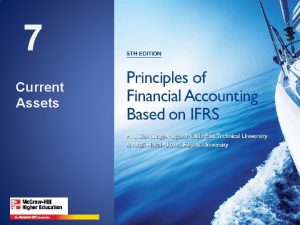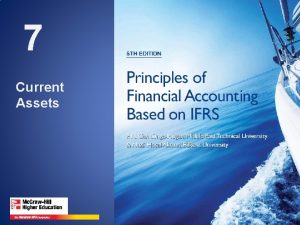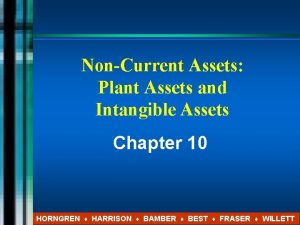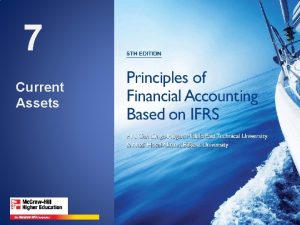Enterprise Assets Management EGS 5622 Enterprise Systems Integration






































- Slides: 38

Enterprise Assets Management EGS 5622 Enterprise Systems Integration Spring, 2016

Enterprise Assets Management (EAM) Concepts & Theories

Asset Accounting Tracking the financial consequences associated with the entire lifecycle of an asset, from acquisition to disposal (retirement). Assets can be categorized as tangible, intangible, and financial 3

Asset Accounting Classification Tangible assets ◦ Fixed assets ◦ Leased assets ◦ Assets under construction Intangible assets ◦ Intellectual property ◦ Patents ◦ Trademarks Financial assets ◦ Securities ◦ Long term notes (debts) ◦ Mortgages 4

Asset Accounting Components Asset accounting Tangible assets Intangible assets - Fixed assets - Leased assets - Assets under construction - Intellectual property - Patents -Trademarks Financial assets - Securities - Long term notes (debts) - Mortgages

Asset Accounting in corporate financial structure Chart of Accounts General Ledger Accounts ◦ Balance sheet accounts ◦ Income statement accounts ◦ Reconciliation accounts Subsidiary ledgers (sub ledgers) ◦ Accounts Receivable (customers) ◦ Accounts Payable (vendors) ◦ Assets 6

Asset Accounting Assets are assigned ◦ company code ◦ Business area to Accounting data of assets are maintained in asset sub-ledger accounts. ◦ E. g. Acquisition costs and depreciation Asset sub-ledger accounts are created when asset master record is created and associated with a reconciliation account in the general ledger Sub-ledger account and the master record share the same account number Companies maintain separate reconciliation accounts for different types of assets 7

Example of Asset Reconciliation Accounts in GL 8

Asset Accounts (AA) Structure Example 9

Asset Management (Lifecycle) Cost center Asset master creation (AA) Vendor master Vendor invoice Outgoing payment Asset Acquisition (AA) Asset Report (AA) Plant/location External Asset Addition (AA) Depreciation Charge Asset Transfer (AA) Asset Retirement (AA) Within/outside Company code Business Area Customer Master Customer/Scraping Customer Invoice Customer Payment

Major Activities in Asset Management (Lifecycle) Asset Acquisition 2. Asset Depreciation 3. Asset Retirement 1. 11

Asset Acquisition 1. Asset acquisition is concerned with acquiring assets via internal or external processes 1. 1 Internal: production process or project systems 1. 2 External: Three external options for purchasing assets, 1) Purchase from an established vendor using the purchasing process (different GL accounts) 2) Purchase from an established vendor without using the purchasing process (manual entry in GL and subledger; similar to AP accounting) 3) Purchase from a one-time vendor or a vendor for whom master data are not maintained (via clearing account). 12

Asset Acquisition With a Clearing Account 5, 000 3 Goods receipt Magal and Word | Integrated Business Processes with ERP Systems | © 2011 13

2. Asset Depreciation Asset depreciation is concerned with the decrease in the value of an asset over time Depreciation can be planned or unplanned Depreciation methods are used ◦ Straight line ◦ Double declining balance Useful life Residual value Book value Depreciation areas: parallel valuation for each fixed asset for different purposes such as cost accounting or tax purpose. Magal and Word | Integrated Business Processes with ERP Systems | © 2011 14

Straight Line Depreciation Magal and Word | Integrated Business Processes with ERP Systems | © 2011 15

Double Declining Balance Depreciation Magal and Word | Integrated Business Processes with ERP Systems | © 2011 16

Financial Statements Based on Depreciation Areas (parallel valuation) Magal and Word | Integrated Business Processes with ERP Systems | © 2011 17

3. Asset Retirement Concerned with the disposal or retirement of an asset after its useful life Retirement may be: ◦ Revenue generating (sold) ◦ Non-revenue generating (scrapped) Magal and Word | Integrated Business Processes with ERP Systems | © 2011 18

Asset Explorer Asset explorer provides an overview of all activities related to the asset, including: ◦ Acquisition data ◦ Planned and posted (actual) depreciation ◦ Drill-down details for: Master data Transactions Documents ◦ Depreciation posting run (for an assumed useful life) 19

Asset Explorer (continued) Asset explorer can: display connections from the Asset Explorer to the G/L accounts, vendor accounts, cost centers, and the Purchase Order of the Asset display planned values, as well as values already posted for analyzing asset values

Asset Explorer Interface Magal and Word | Integrated Business Processes with ERP Systems | © 2011 21

Asset management linked to financial accounting Magal and Word | Integrated Business Processes with ERP Systems | © 2011 22

Enterprise Assets Management (EAM) SAP Implementation

SAP Module View Sales & Distribution Financial Accounting Materials Mgmt. Controlling Fixed Assets Mgmt. Production Planning Quality Mgmt. Plant Maintenance Human Resources Integrated Solution Client / Server Open Systems Project System Workflow Industry Solutions

Enterprise Asset Management (EAM) Process 1. Notification 2. Planning 3. Controlling 4. Implementation 5. Completion

1. Notification Malfunctions and other requirements are gathered in notifications Content: ◦ Technical object ◦ Location data ◦ Reported by ◦ Description ◦ Notification date ◦ Breakdown ◦ Damage location, damage cause code

1. Notification (continued) Functions as requirement analysis and documentation maintenance actitvities Contains rather technical information Describes an exceptional state Requests necessary maintenance measures Already done works can be documented

2. Planning Order creation and order planning on basis of notified requirements Order planning contains: ◦ Performed steps (Operations) ◦ Needed materials (Components) ◦ Required tools

2. Planning (continued) Maintenance order is created in maintenance plans, based on notifications or without any reference objects Responsibilities (external or internal) are allocated Material reservations and where-usedlists Production resource (e. g. protective clothing) Cost estimation

3. Controlling Different maintenance order verification Order release Contains the following functions: ◦ Mass change or mass editing ◦ Availability check ◦ Capacity requirements planning ◦ Order release ◦ Printing shop floor papers

4. Implementation of maintenance orders Planned/unplanned (goods issue) material withdrawal

5. Completion Composition of completion: ◦ Time confirmation ◦ Technical completion confirmation ◦ Business completion (no further cost can be added) Billing after successful business completion

Create Asset Master

Create Asset Master

Asset Master Purchasing an Asset

Purchasing an Asset One way to skip the step of creating an Asset in the books is to directly go to the Purchase Order, and click the button pointed to.

Asset Explorer

Lab 3 Exercises (Due date 2/24/2016) 1. Create asset 2. Purchase asset 3. View Asset Explorer 4. EAM process overview 5. Create malfunction report 6. Open maintenance order from malfunction report 7. Release maintenance order 8. Confirm maintenance order 9. Analyze final costs and technical completion 10. Account for maintenance order 11. Analyze costs and finish maintenance order 12. Display maintenance order history
 Real and financial assets
Real and financial assets Real assets vs financial assets
Real assets vs financial assets Real assets definition
Real assets definition Plant assets natural resources and intangible assets中文
Plant assets natural resources and intangible assets中文 Plant assets natural resources and intangible assets
Plant assets natural resources and intangible assets Lanni products is a start up computer
Lanni products is a start up computer Plant assets, natural resources, and intangible assets
Plant assets, natural resources, and intangible assets Egs accounting
Egs accounting Egs
Egs Egs.bildung-rp.de
Egs.bildung-rp.de Kaic calculator
Kaic calculator Three dimensions of corporate strategy
Three dimensions of corporate strategy Vertical diversification example
Vertical diversification example Simultaneous integration meaning
Simultaneous integration meaning What is project integration management
What is project integration management Current assets management
Current assets management Infrastructure and asset management
Infrastructure and asset management Asset management vs project management
Asset management vs project management Enterprise integration reference architecture
Enterprise integration reference architecture Presentation integration model example
Presentation integration model example Enterprise integration strategy
Enterprise integration strategy System integration patterns
System integration patterns Case study on enterprise architecture and integration
Case study on enterprise architecture and integration Tieto teis
Tieto teis Disadvantages of enterprise application integration
Disadvantages of enterprise application integration Gdais
Gdais Tieto enterprise integration server
Tieto enterprise integration server Tieto enterprise integration server
Tieto enterprise integration server Tdc systems integration
Tdc systems integration Software integration plan
Software integration plan Energy systems integration facility
Energy systems integration facility Advanced systems integration
Advanced systems integration Integration using tables and computer algebra systems
Integration using tables and computer algebra systems Systems integration specialists
Systems integration specialists Tdc systems integration
Tdc systems integration Putting the enterprise into the enterprise system
Putting the enterprise into the enterprise system Putting the enterprise into the enterprise system
Putting the enterprise into the enterprise system Application of enterprise resource planning
Application of enterprise resource planning Free enterprise system def
Free enterprise system def
